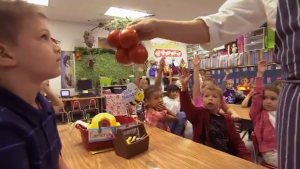
Classroom activities
Here you’ll find some practical ideas for working with the clip. Choose the ones that suit your teaching aims, particular group of learners, your teaching style, and then plan your own lesson.
PRE-VIEWING ACTIVITIES
‘Initials’
Put the initials J_____ O______ on the board, and ask students to guess who you’re thinking of by giving clues:
- male
- 37 years old
- British
- has published books
- creative in the kitchen
- passionate about cooking
- chef
‘Food chunks’
Put ‘______ food’ on the board, and ask students to come up with as many adjectives as they can which go with ‘food’. You can add/elicit ideas (e.g. fast -, slow -, local -, tasty -, home-made -, nutritious -, low-fat -, junk -, healthy -, comfort -)
‘Food education’
Put ‘Food Education’ on the board. Tell your students that this is the name of a new subject which will be introduced at their school. They have 5 minutes to decide what content it should include and how it should be taught.
‘Change topic, change direction’
Put the following on the board: ‘Topic 1: Healthy food Topic 2: Junk food’.
Do a brainstorm chain (the next student in the circle or in the row has to say a word or an expression). There are two rules:
- if someone calls out ‘Change topic!’, the one to continue needs to move to the other topic.
- if someone calls out ‘Change direction!’, the chain reverses direction. You can’t change topic or direction if it’s your turn to say a word.
Note: This is a high-energy brainstorming activity which usually creates a lot of laughter. Students usually enjoy the power that they can change topic or direction.
‘Word Detectives 1′
Tell students that they are detectives investigating a mystery. The mystery has to do with ‘food’. Give each student a ‘clue’ i.e. a card with a word. Tell them that they need to become experts on this word: find out everything they can about it. They can do this using handheld devices or dictionaries in class, or as an out-of-class assignment. Demonstrate with one or two examples. (e.g. meaning(s), common collocations, usage, pronunciation). After they have done their task, they present their words in class. Here is list of words from the transcript: profound / lifespan / landscape / paranoid / disease / sweep / massive / healthcare / tip /ripe / preventable / succeed / judge / rant / ambassador / tight / epitome / fizzy / tangible / responsibility / magic / sustainable.
Note: The mystery, of course, is understanding the message fully! Focusing on some of the key words before viewing primes their mind for recognition. It’s a good idea to pause the clip and have a 10 seconds processing silence in a few places. If they watch the clip at home, encourage them to do this.
WHILE VIEWING ACTIVITIES
‘Word Detectives 2′
If you’ve done the ‘Word Detectives1’ activity, ask each student to listen for their word and note down the context in which it appears. Alternatively, you can give all the students the list of words and ask them to note down all the contexts. Here are the contexts for the words suggested: profoundly believe / shorter lifespan / paranoid about death / diet-related disease / sweeping the world / massive problem / healthcare bills / tipping point / ripe for picking / preventable disease / succeed in life / judging the circumstances / crack into my rant / food ambassador, I offer myself as their ambassador / tight budgets / epitomizes the trouble / fizzy pop / tangible change / corporate responsibility / magic wand / sustainable funding
POST-VIEWING ACTIVITIES
‘Word Detectives 3′
Check the contexts for the words given.
‘Plan a food lesson’
Show the image below and ask students to recall what was happening at this point in Jamie’s story. Then ask them to plan a lesson to educate kids about food.

‘Gandhi story’
Tell your students the story below. Stop before the last two lines. Invite them to finish the story before you tell them the ending. Then ask them to make a link between the story and Jamie Oliver’s talk. What similarities can they think of?
“The Little Boy and Sugar”
One day a mother came to Gandhi with her little boy for help. She asked Gandhi, Please, Bapu, will you tell my little boy to stop eating sugar. He simply eats too much sugar and will not stop. Gandhi told the mother to leave and come back with the boy in three days. The mother returned with her son and said to Gandhi. We have come back as you asked, Gandhi turned to the boy and said, “Young boy, stop eating sweets. They are not good for you. ”The mother then asked Gandhi, “Bapu, why didn’t you tell my son that when we first came to see you? Why did you ask us to leave and come back in three days? I don’t understand.” Gandhi said to the woman, “I asked you to return with the boy in three days, because [stop here] ……
Ending: … three days ago, I, too, was eating sweets. I could not ask him to stop eating sweets so long as I had not stopped eating sweets.”

Jamie is a compelling speaker, really gifted.
SUBTITLES IF NEEDED: His TED talk also has subtitles available in 41 languages. It is possible to use those subtitles with students who can’t quite follow his presentation at points.
OBESITY AS EPIDEMIC: This talk is aimed at an American audience. Nowadays one in three Americans is classified as ‘obese.’ Fifty years ago that was very different. What causes excessive weight in youngsters and young adults? Is it just the food the eat? Genetic factos? Too much sitting at computers, not playing outside? Too much riding in cars, not walking or on bicycles?
JAMIE’S WISH: Jamie wants a ‘food revolution’ in the U.S., Great Britain and across much of the ’developed world.’ He says at the end (21:00): My wish is to help a strong sustainable movement to educate every child about food, to inspire families to cook again, and empower people everywhere to fight obesity.” Is this needed in your own country?
NAME THE VEGETABLE: If you are teaching younger kids, a nice clip he shows is showing youngsters some vegetable in a school class and asking them if they know what it is (11:15 in the video). This is the photo for ‘plan a food lesson’ in the worksheet. The British kids he asks, maybe 7 years old, don’t know a number of the vegetables he shows them, including mushrooms and zucchini. Maybe kids where you are do. He uses vegetables because kids often know sweet fruits, coz they eat them—but can’t identify too many fresh veggies. What vegetables are common where you live and maybe not found much elsewhere?
SCHOOL FOOD: He talks a lot about school food and how it needs to be changed (from 8:48 in video). What kind of food is available where you teach? Do pupils get lunch served? What, for example? There needs to be a new standard of fresh, proper food for your children”
LEARNING HOW TO COOK: At 16:55 he says kids need to “know how to cook 10 recipes that will save their lives” by the time they finish school. How many of your pupils know how to cook? These are life skills that are disappearing in many urban areas. And boys (or their dads) may have few such skills. Jamie has written many cookbooks. You can find a few (see below).
CORPORATE-CONTROLLED FOOD: What does Jamie think about supermarket chains and big food corporations?
ADDITIVES: What does Jamie say about ‘additives’ in foods? Today much of what people eat is full of chemicals? Why? MSG is added in many kinds of tasty noodle, Asian foods. Some people are very allergic to MSG. Also, some vegetables have high amounts of some chemical due to the fertilizers used, and this can make people sick. Maybe your students know some stories from experience.
LABELING: What does he say about labeling? There are strong movements in some countries to have very clear labeling in bigger print on foods we buy. Labels that people can understand. Including very clearly how many calories in a portion that they can understand. In your country, is there discussion about labeling? Are people waking up to this problem?
GARDENING: Jamie doesn’t mention much about home gardening, but this is a good source of ‘real’ and wholesome vegetables and fruits. Do any of your pupils have gardens, know how to tend them? Maybe their grandparents too, or relatives who live in a village. A good topic to raise.
LANGUAGE: Jamie uses a lot of slang or words students may know from computer talk. For example, in talking about a whole change in our food culture, he says: “we got a problem, we need to reboot.” What is the meaning of ‘reboot’ here? Have students listen to the talk again in groups and notice words that seem to be colloquial or slangy. What about his accent?
WHO IS JAMIE? You can find out more about Jamie Oliver by looking for him in Wikipedia. He grew up in Essex the south of England, and his accent reflects that. Most students will never have heard a working-class Essex accent. His father ran a pub. That is where Jamie learned how to cook already as a young boy.
He owns his own holding company, “Sweet as Candy,” which has made him wealthy enough. He established a whole number of restaurants focusing on healthy food. He’s written many books, try to find a few at amazon in the UK. One is called JAMIE’S MINISTRY OF FOOD. ANYONE CAN LEARN TO COOK IN 24 HOURS (2008). His book COOK WITH JAMIE (2006) is also good and you can find very cheap copies.
FOOD MONTH TIE-IN: It is good to combine this eLesson and worksheet with other materials from the GISIG Food Month site. Go to Resources on the GISIG site, then Food Issues Month. ‘Week 2 Summary!’ has many links, including an excellent Pinterest page.